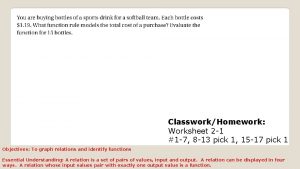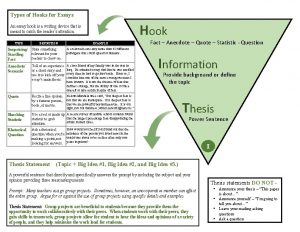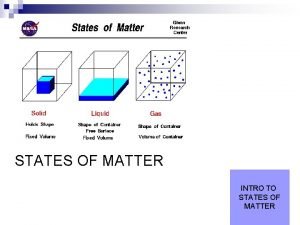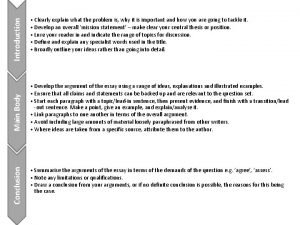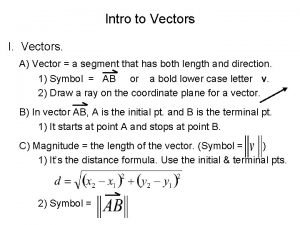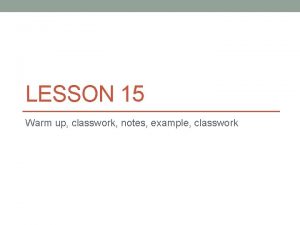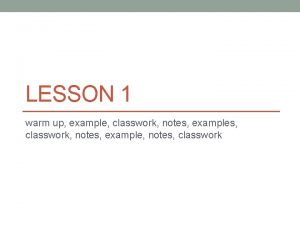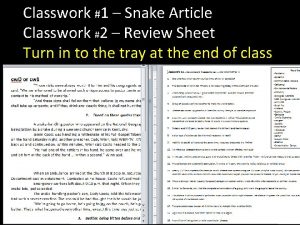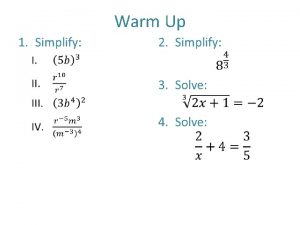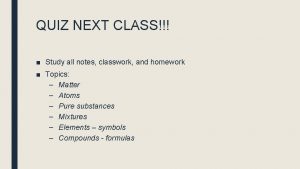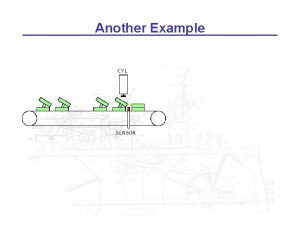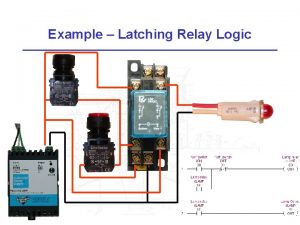LESSON 11 Warm up intro example notes classwork














































- Slides: 46

LESSON 11 Warm up, intro, example, notes, classwork

Warm Up

Warm Up

Example, part 1 Now try working backward. Rewrite the following standard form quadratic expressions as perfect squares. What’s different about the last row? How could you change it so that it could be a perfect square?

Example, part 2 To be a perfect square, want the same factors on each side of the square. To “complete the square” the corner should have 16, but we only have 3.

Notes – Completing the Square In order to rewrite a quadratic expression or equation as a perfect square binomial, the 3 rd term (c) must be half of the middle term (b), squared. If it isn’t already, you can adjust the expression or equation. In doing so, make sure you maintain equivalency: Expression (Lesson 11 -12): add AND subtract the same number (so you are really just adding 0). Equation (Lesson 13 and beyond): do the same thing to both sides of the equation

Classwork Must Do May Do • Classwork 11 #1 - 8 • Khan Academy • Reflection questions • Exponents review • Linear equation practice • Slope practice • Test completion • Classwork 11 #9 -10

LESSON 12 Warm Up, example, notes, example, classwork

Warm Up

Example 1

Notes – Business Application Vocab •

Example 2 •

Workshop Must Do May Do • Classwork 12 #1 -6 • Complete cw #11 • Summary/Reflection • Khan Academy • Crossing River/Carnival Bears • Linear Equation practice • Exponents review • Slope practice

LESSON 13 Warm up, example, notes, example classwork

Warm Up •

Example 1 •

Example 1, follow up •

Notes •

Example 2 • •

Classwork Must Do May Do • Exit ticket 11 -12 • Khan Academy • Classwork 13 #1 -4 • Exponents review • Reflection/summary • Linear practice question • Slope practice • Test rewrites

LESSON 14 Warm up, intro, notes, examples, classwork

Warm Up • Which of these problems makes more sense to solve by completing the square? Which makes more sense to solve by factoring? How could you tell early in the problem solving process which strategy to use?

Intro •


Notes – The Quadratic Formula • The axis of symmetry/vertex Step left and right this amount to the x-intercepts

Example •

Classwork Must Do May Do • Classwork 14 #1 -6 • Khan Academy • Summary/reflection • Exponents review • Linear practice • Slope practice • Test rewrites

LESSON 15 Warm up, classwork, discussion, notes, classwork

Warm Up • What are the differences between the two? Is there more than one way to solve? Is one pathway MORE correct than another?

Classwork, part 1 Complete problems 1 -5 using the quadratic formula. THINK: #1 – what is an easier way to solve this problem? #2 – what’s confusing about this problem? #3– 5 – how many solutions do these equations have?

Discussion Describe the solutions of these quadratic equations. What makes these equations different?

Notes

Classwork Must Do May Do • Exit ticket #11 -12 • Khan. Academy • Classwork 15 #1 -10 • Crossing the • Summary question River/Carnival Bears • Exponents review • Linear practice • Slope practice • Classwork 15 #11 -12 • Make up classwork 11 -14

LESSON 16 Warm up, review, examples, notes, classwork

Warm Up •

Recall This chart holds true for quadratic functions. For the parent function y=x 2, the vertex is (0, 0). Translations move the vertex.

Examples •

Notes •

Workshop Must Do May Do • Exit ticket 14 -15 • Khan. Academy • Classwork 16 • Linear equation practice • Summary/reflection • Exponents review questions • Slope practice • Vocabulary work • Lesson 15 extensions

LESSON 17 Warm up to example, notes, classwork

Warm Up •

Example (continued from warm up) •

Example (continued from warm up) • What features are visible in standard form? What about in vertex form?

Example Summary / Notes An equation given in standard form quickly reveals the yintercept (c) and general shape and direction (a) of the graph. To graph it you can: --Factor it to find the x-intercepts (when y = 0) and then find the vertex by averaging the x-intercepts. -- Complete the square to find the vertex and then set equal to 0 and solve to find the x-intercepts --Use the quadratic formula to find the x-intercepts. Stilll need the vertex. --Plot the points you know (at least 3 required)

Example, last part • Key Features: x and y-intercepts and the vertex What is an appropriate domain? Range? What do the 3 and 150 represent? What do the zeros of the function tell us about the ball’s flight?

Workshop Must Do May Do • Classwork 17 #1 -7 • Khan. Academy • Summary/reflection • Classwork 15 extensions question • Linear equation practice • Exponents review • Slope practice • Vocabulary section
 Http://www.explorelearning.com
Http://www.explorelearning.com Classwork/homework linear functions answer key
Classwork/homework linear functions answer key Welcome to google classroom
Welcome to google classroom Classwork 1-1 point line plane answers
Classwork 1-1 point line plane answers Words their way schedule
Words their way schedule Facteur g
Facteur g Thematic essays examples
Thematic essays examples Dramatic hook example
Dramatic hook example Intro body conclusion example
Intro body conclusion example Example of introduction paragraph
Example of introduction paragraph Ancedote examples
Ancedote examples Funnel introduction example
Funnel introduction example Bless me ultima plot diagram
Bless me ultima plot diagram Intro paragraph apush
Intro paragraph apush How to write a thesis statement for apush
How to write a thesis statement for apush Apush thesis statement examples
Apush thesis statement examples Intro victor hugo
Intro victor hugo Different types of hooks for essays
Different types of hooks for essays Comparison essay block method
Comparison essay block method Intro body conclusion
Intro body conclusion Intro qr codes
Intro qr codes Intro to matter
Intro to matter Introduction of advertisement
Introduction of advertisement Planeternas omloppstid
Planeternas omloppstid Intro to reverse engineering
Intro to reverse engineering Relationship essay introduction
Relationship essay introduction Part of research paper
Part of research paper Introduction to organic chemistry
Introduction to organic chemistry Intro to offensive security
Intro to offensive security Mitt i naturen intro
Mitt i naturen intro Workshop
Workshop Lord of the flies thesis
Lord of the flies thesis Leq essay format
Leq essay format Introduction texte descriptif exemple
Introduction texte descriptif exemple Introduction paragraph examples
Introduction paragraph examples Andrew ng intro machine learning
Andrew ng intro machine learning Intro to verilog
Intro to verilog Severance intro
Severance intro Intro to ifs
Intro to ifs Antonino virgillito
Antonino virgillito Introduction of
Introduction of Kfc intro
Kfc intro Body conclusion introduction
Body conclusion introduction Vlsi design tutorial
Vlsi design tutorial Intro to vectors
Intro to vectors Intro to typography
Intro to typography Sound of music intro
Sound of music intro

